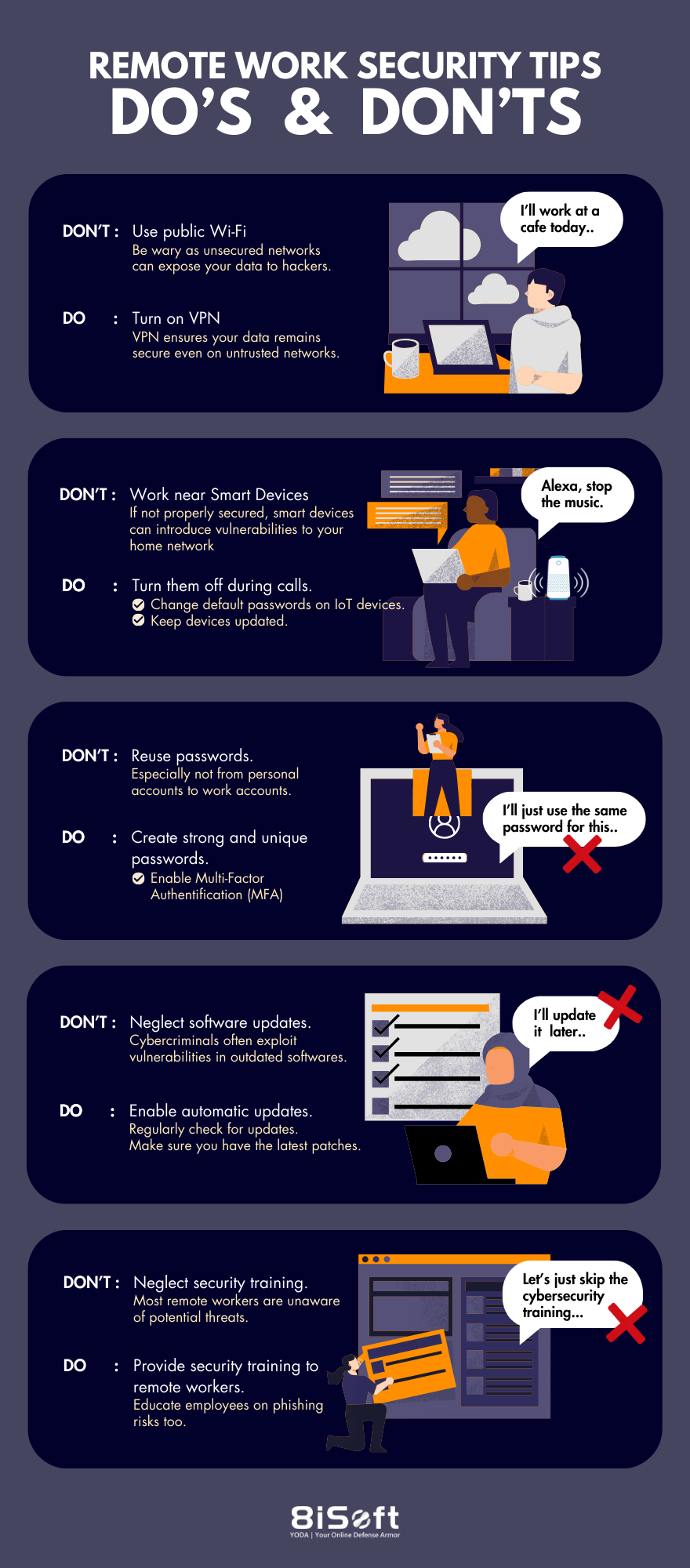Top Remote Work Security Tips: Do’s and Don’ts Infographic
In recent years, remote work has become more common in corporate culture. Many companies have even adopted hybrid models, offering employees the flexibility of working remotely from home part time. Although there are many benefits to working at home such as the increased flexibility and reduced commute times, it also introduces new cybersecurity risks that must be addressed to safeguard you and your organization’s sensitive information.
Understanding the Risks of Remote Work
The decentralized nature of remote work is the main reason why remote work can bring so many security risks. Remote workers access company networks from various locations and devices, relying on potentially vulnerable home set ups and public Wi-Fi networks. This increased exposure can lead to higher risks of cyber attacks, including phishing attempts, malware infections, and data breaches.
Moreover, the rapid adoption of Internet of Things (IoT) devices in home environments further complicates this risk. Smart appliances, voice assistants, and security cameras, while enhancing convenience, often come with inherent security weaknesses that can be exploited by cybercriminals. These devices, if not properly secured and monitored, serve as potential entry points into home networks and, subsequently, into corporate systems when employees connect remotely.
To mitigate these risks, organizations must implement comprehensive cybersecurity protocols tailored to the remote work environment. Take a look at our infographic for some security best practices and tips for working from home:


Remote Work Security Best Practices
1. Secure Networks
Public Wi-Fi networks are notoriously insecure and should be avoided when handling sensitive information. Use a Virtual Private Network (VPN) to encrypt data transmitted over public networks, ensuring confidentiality and integrity.
2. Secure Home Network Devices
Be cautious of IoT devices like smart speakers and home security systems as they can be vulnerable to cyber attacks. Minimize risks by isolating work activities from these devices or turning them off during work hours. Also ensure that they are updated with the latest security patches.
3. Strong Authentication
Avoid using weak passwords and refrain from reusing passwords across multiple accounts as it increases the risk of unauthorized access if one account is compromised. Instead, use strong, unique passwords combining letters, numbers, and special characters. Enable multi-factor authentication (MFA) wherever feasible to add an extra layer of security.
4. Regular Updates
Don’t delay or ignore software updates, as outdated software can be more susceptible to cyber attacks. Keep all devices and software up to date with automatic updates enabled.
5. Security Training
Provide comprehensive cybersecurity training, especially for remote workers. Cover topics such as recognizing phishing attempts, creating secure passwords, and identifying suspicious online activities. Educated employees are your first line of defense against cyber threats. Don’t neglect security training.
In addition to implementing these essential security practices, integrating a robust vulnerability management tool is crucial for additional protection in remote work environments. Vulnerability Management Tools like 8iSoft YODA continuously scan for and prioritize potential vulnerabilities across devices and networks, ensuring timely patch deployment and adherence to security policies. By proactively managing risks and maintaining up-to-date defenses, organizations can effectively safeguard sensitive information in today’s remote work environments.
